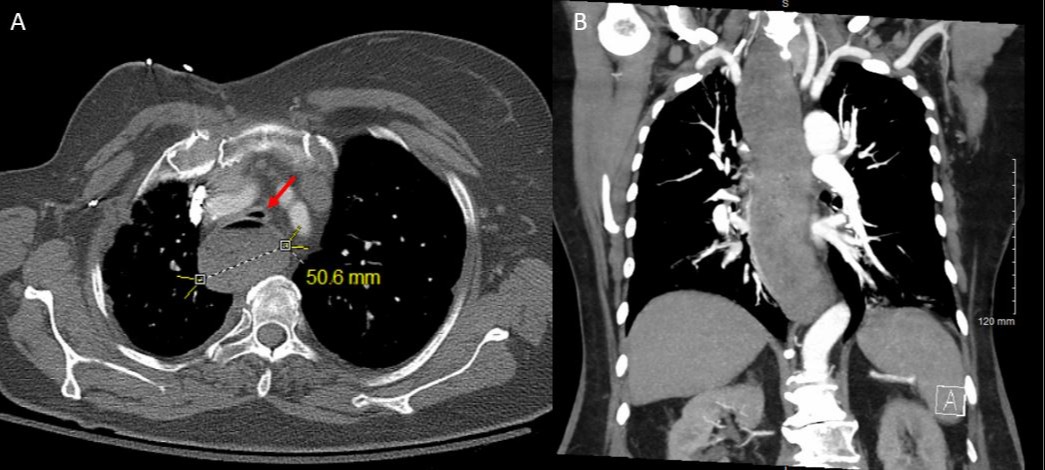Back


Poster Session A - Sunday Afternoon
Category: Esophagus
A0210 - Tracheal Compression as an Initial Presentation of Achalasia
Sunday, October 23, 2022
5:00 PM – 7:00 PM ET
Location: Crown Ballroom

Has Audio

Codey Pham, MD
Baylor College of Medicine
Houston, TX
Presenting Author(s)
Gabriel Bustamante, MD, Chaitra Banala, MD, Codey Pham, MD, Anthony Xu, MD
Baylor College of Medicine, Houston, TX
Introduction: Achalasia is due to esophageal dysmotility and impaired lower esophageal sphincter relaxation. It is often insidious in presentation with gradual disease progression. We present a case of acute respiratory failure due to external compression of the trachea by a dilated esophagus as an initial presentation of achalasia.
Case Description/Methods: An 80-year-old female with degenerative cerebellar ataxia and prior breast cancer treated with mastectomy and chemoradiation presents with acute respiratory failure due to esophageal compression of the trachea. The week prior to her admission, the patient had mild coughing following meals, but never had symptoms of dysphagia or reflux. She experienced sudden onset dyspnea with rapid progression prompting her to present to an outside hospital where she was found to be in severe respiratory failure with audible stridor. She was intubated and computed tomography showed a dilated food-filled esophagus with external compression of the intrathoracic trachea. She was transferred to our institution for a higher level of care. On arrival, the patient was already intubated and sedated. Review of external imaging showed a dilated food-filled esophagus to around 5cm with external compression of the intrathoracic trachea. Esophagogastroduodenoscopy (EGD) showed retained food throughout the esophagus with a hypertonic lower esophageal sphincter. The sphincter was dilated to 10mm using balloon dilation and the food was passed into the stomach. Subsequent EGD was performed with Botox injection into the lower esophageal sphincter. It was determined that the underlying cause of the patient’s esophageal dilation was due to undiagnosed achalasia likely related to her underlying cerebellar ataxia. The patient was subsequently extubated and tolerated an oral diet. She was discharged with plan for outpatient follow up.
Discussion: Achalasia is typically an insidious disease most commonly presenting as dysphagia initially. In this case, the initial presentation of achalasia was tracheal compression due to a dilated esophagus from previously undiagnosed achalasia likely secondary to long standing cerebellar ataxia. Tracheal compression is an uncommon complication of achalasia and is rarely the initial presentation. Early recognition of achalasia and its spectrum of illness severity is important to prevent serious complications of the disease.

Disclosures:
Gabriel Bustamante, MD, Chaitra Banala, MD, Codey Pham, MD, Anthony Xu, MD. A0210 - Tracheal Compression as an Initial Presentation of Achalasia, ACG 2022 Annual Scientific Meeting Abstracts. Charlotte, NC: American College of Gastroenterology.
Baylor College of Medicine, Houston, TX
Introduction: Achalasia is due to esophageal dysmotility and impaired lower esophageal sphincter relaxation. It is often insidious in presentation with gradual disease progression. We present a case of acute respiratory failure due to external compression of the trachea by a dilated esophagus as an initial presentation of achalasia.
Case Description/Methods: An 80-year-old female with degenerative cerebellar ataxia and prior breast cancer treated with mastectomy and chemoradiation presents with acute respiratory failure due to esophageal compression of the trachea. The week prior to her admission, the patient had mild coughing following meals, but never had symptoms of dysphagia or reflux. She experienced sudden onset dyspnea with rapid progression prompting her to present to an outside hospital where she was found to be in severe respiratory failure with audible stridor. She was intubated and computed tomography showed a dilated food-filled esophagus with external compression of the intrathoracic trachea. She was transferred to our institution for a higher level of care. On arrival, the patient was already intubated and sedated. Review of external imaging showed a dilated food-filled esophagus to around 5cm with external compression of the intrathoracic trachea. Esophagogastroduodenoscopy (EGD) showed retained food throughout the esophagus with a hypertonic lower esophageal sphincter. The sphincter was dilated to 10mm using balloon dilation and the food was passed into the stomach. Subsequent EGD was performed with Botox injection into the lower esophageal sphincter. It was determined that the underlying cause of the patient’s esophageal dilation was due to undiagnosed achalasia likely related to her underlying cerebellar ataxia. The patient was subsequently extubated and tolerated an oral diet. She was discharged with plan for outpatient follow up.
Discussion: Achalasia is typically an insidious disease most commonly presenting as dysphagia initially. In this case, the initial presentation of achalasia was tracheal compression due to a dilated esophagus from previously undiagnosed achalasia likely secondary to long standing cerebellar ataxia. Tracheal compression is an uncommon complication of achalasia and is rarely the initial presentation. Early recognition of achalasia and its spectrum of illness severity is important to prevent serious complications of the disease.

Figure: Thoracic computed tomography with intravenous contrast. (A) Axial and (B) coronal views demonstrate a dilated esophagus to 5cm with associated compression of the trachea demonstrated by the red arrow.
Disclosures:
Gabriel Bustamante indicated no relevant financial relationships.
Chaitra Banala indicated no relevant financial relationships.
Codey Pham indicated no relevant financial relationships.
Anthony Xu indicated no relevant financial relationships.
Gabriel Bustamante, MD, Chaitra Banala, MD, Codey Pham, MD, Anthony Xu, MD. A0210 - Tracheal Compression as an Initial Presentation of Achalasia, ACG 2022 Annual Scientific Meeting Abstracts. Charlotte, NC: American College of Gastroenterology.
